PPE-related headaches common among health care workers: report

North Kingstown, RI — More than 4 out of 5 health care workers experience headaches associated with the use of personal protective equipment, according to a new report from the Association of Migraine Disorders.
“De novo” headaches have the characteristics of a primary headache disorder such as migraine or tension, the organization says. Cases appear to present similarly to an external compression headache, caused by an N95 mask or eye protection placing continuous pressure on the forehead or scalp.
The report cites a March 2020 study of 158 health care workers at National University Hospital in Singapore, in which 81% of the workers reported PPE-related headaches when wearing an N95 mask. All of the affected workers experienced bilateral headaches, which cover both sides of the head.
The workers who wore PPE more than four hours a day were most likely to develop headaches, whether they wore an N95 facemask, protective eyewear or both. Further, the onset of a headache after donning an N95 mask or protective eyewear was less than 60 minutes for 81% and 88% of the affected workers, respectively. After removing the PPE, around 88% of the workers reported their headache resolved within 30 minutes.
The report also cites a July 2021 study of 306 physicians, nurses and other health workers at a hospital in Spain. More than half of the participants (51.6%) reported experiencing headaches associated with the use of a filter mask. Nearly a third (29.5%) said their headache lasted one to four hours, while 9.6% endured a headache that lasted at least 12 hours.
The association hypothesizes that the following may play a role in de novo PPE-associated headaches:
- Pressure placed on the sensory nerves by PPE (specifically from straps)
- Strain on the neck caused by the application and extra weight of PPE, which can trigger trigeminocervical complex – thought to impact distribution of migraine headache pain
- Anxiety and/or stress
- Low blood oxygen levels or breathing in too much carbon dioxide
“If staff members are suffering from de novo PPE-associated headaches, a discussion with management may be necessary to find a solution,” the report states. “It may be more beneficial for staff to wear PPE as needed rather than for an entire shift. If de novo PPE-associated headaches are new, it is important to find a clinician who specializes in headache medicine.”
Post a comment to this article
Safety+Health welcomes comments that promote respectful dialogue. Please stay on topic. Comments that contain personal attacks, profanity or abusive language – or those aggressively promoting products or services – will be removed. We reserve the right to determine which comments violate our comment policy. (Anonymous comments are welcome; merely skip the “name” field in the comment box. An email address is required but will not be included with your comment.)

